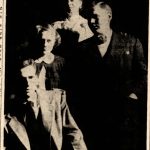
The Glass Menagerie
Performances
January 26 & 27, 1950
Venue
Scottish Rite Temple
Synopsis
Amanda Wingfield is a faded, tragic remnant of Southern gentility who lives in poverty in a dingy St. Louis apartment with her son, Tom, and her daughter, Laura. Amanda strives to give meaning and direction to her life and the lives of her children, though her methods are ineffective and irritating. Tom is driven nearly to distraction by his mother’s nagging and seeks escape in alcohol and the world of movies. Laura also lives in her illusions. She is crippled, and her condition, intensified by her mother’s anxiety to see her married, has driven her more and more into herself. The crux of the action comes when Tom invites a young man of his acquaintance to take dinner with the family. Jim, the caller, is a nice ordinary fellow who is at once pounced upon by Amanda as a possible husband for Laura. In spite of her crude and obvious efforts to entrap the young man, he and Laura manage to get along very nicely, and momentarily Laura is lifted out of herself into a new world. But this world crashes down when, toward the end, Jim explains that he is already engaged. The world of illusion that Amanda and Laura have strived to create in order to make life bearable collapses about them. Tom, also at the end of his tether, at last leaves home.
Author: Tennessee Williams
Historian’s Corner
With “The Glass Menagerie” Players experimented in fostering a closer relationship with the community’s sources of dramatic talent by cooperating with Illinois Wesleyan University and its teaching staff, particularly Professor Lawrence Tucker and Professor Harvey K. Smith. Professor Tucker supervised Robert Price who directed and performed the part of Tom. Professor Smith, the Technical Director at IWU, designed the set and worked with the stage setting committee. Players also confirmed that the previously announced “Harvey” had not been made available for amateur production, so a replacement was required. The new show was to be Sam and Bella Spewack’s political satire “Two Blind Mice.”






